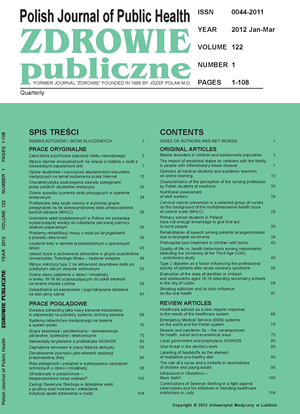Cervical cancer prevention in a selected group of nurses on the background of the Multidimensional Health Locus of Control Scale (MHLC)
Keywords:
cervical cancer, prevention, risk factorsAbstract
Introduction. The opportunities to improve prevention and early detection of cervical cancer and improvement of the treatment outcomes are closely related to knowledge, attitudes and women’s behavior. Nurses and midwives due to the specificity of their work have a significant role in the prevention and early detection of female cancers.
Aim. Evaluation of prevention cervical cancer in a group of nurses on the background of the Multidimensional Health Locus of Control Scale (MHLC).
Material and methods. The study was carried out in September 2008 among 100 randomly selected nurses working in hospitals all around Cracow. The study used the method of diagnostic survey, tools included: a questionnaire and MHLC Scale).
Results. One third of the nurses acknowledged that they had annually gynecological checkup, 15% every six months and more often, and as many as 15% of women did not remember the last time they were at the gynecologist. Pap smear was performed every year by 31% of respondents, every two years by 18% of women, and once every three years by 11%. Nearly one third of nurses had a smear test done more than three years ago, and 12% did not remember the last time it was made. The average value of the internal health locus on the scale of MHLC was 25.60, indicating that the respondents were convinced that the control over their own health depends on themselves.
Conclusions. Nurses’ health behavior reduced the risk of developing cervical cancer, but did not promote its early detection by avoiding the regular gynecological checkups and Pap tests. Nurses were convinced more often that their own health was in their hands but however, did not show this type of behavior in the preventive actions.
References
1. Raport na podstawie danych Centrum Onkologii, Instytut im M. Skłodowskiej-Curie, Warszawa. http://epid.coi.waw.pl/krn/, data wejścia:12.12.2010.
2. Bulsa M, Czaja-Bulsa G. Profilaktyka pierwotna i wtórna raka szyjki macicy. Family Medicine& Primary Care Review. 2006;8(2):373-4.
3. Kerr M. Smoking Increases Risk of Squamous Cell Cervical Cancer; Int J Cancer. 2006;118:1481-95.
4. Markowska J. Ginekologia Onkologiczna. Wrocław: Urban & Partner; 2006.
5. Wysocki J. Szczepionki przeciwko ludzkiemu wirusowi brodawczaka. Medycyna Praktyczna-Onkologia. 2007;2:13-7.
6. Szamborski J. Diagnostyka szyjki macicy. Histopatologia. Cytologia. Kolposkopia. Warszawa: PZWL; 2001.
7. Wojciechowska M, Suda K. Promocja zdrowego stylu życia nie tylko zadaniem zawodowym pielęgniarki, ale także odpowiedzią na współczesne zagrożenia zdrowia. Probl Piel. 2008;16(1-2):60-5.
8. Ayres CG. Said another way. Nurses’ role in cancer control. Nurs Forum. 2009;44(1):64-7.
9. Mundt MH, Hermann CP, Conner AL, Von Ah DM. A community partnership model for developing a Center for Cancer Nursing Education and Research. J Prof Nurs. 2006;22(5):273-9.
10. Juczyński Z. Narzędzia pomiaru w promocji i psychologii zdrowia. Pracownia Testów Psychologicznych Polskiego Towarzystwa Psychologicznego. 2001. S.79-86.
11. Spaczyński M. Diagnostyka, profilaktyka i wczesne wykrywanie raka szyjki macicy – rekomendacje Polskiego Towarzystwa Ginekologicznego. Gin Pol. 2006;77(9):655-9.
12. Krasnodębski J, Dawid P, Chudyba R. Współczesne sposoby profilaktyki raka szyjki macicy. Ginekologia Praktyczna. 2007;2:11-4.
13. Spaczyński M, Karowicz-Bilińska A, Rokita W, Molińska-Glura M, Januszek-Michalecka L, Seroczyński P, Uchlik J, Nowak-Markwitz E. Uczestnictwo kobiet w Populacyjnym Programie Profilaktyki i Wczesnego Wykrywania Raka Szyjki Macicy w latach 2007-2009. Gin Pol. 2010;81(09):655-63.
14. Leźnicka M, Mierzwa T, Jachimowicz-Wołoszynek D, Żyrkowski J. System indywidualnych zaproszeń a zgłaszalność kobiet na badania profilaktyczne wykonywane w ramach programów z zakresu profilaktyki onkologicznej. Probl Hig Epidemiol. 2009;90(2):627-30.
15. Stein K, Lewendon G, Jenkins R, Davis C. Improving uptake of cervical cancer screening in women with prolonged history of non-attendance for screening: a randomized trial of enhanced invitation methods. J Med Screen. 2005;12:185-9.
16. Woźniak I. Wiedza o schorzeniach nowotworowych narządów kobiecych i postaw kobiet wobec badań profilaktycznych. Probl Piel. 2008;16(1-2)136-43.


